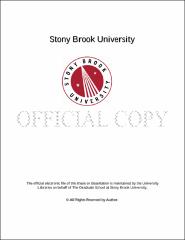| dc.identifier.uri | http://hdl.handle.net/11401/77398 | |
| dc.description.sponsorship | This work is sponsored by the Stony Brook University Graduate School in compliance with the requirements for completion of degree. | en_US |
| dc.format | Monograph | |
| dc.format.medium | Electronic Resource | en_US |
| dc.language.iso | en_US | |
| dc.publisher | The Graduate School, Stony Brook University: Stony Brook, NY. | |
| dc.type | Dissertation | |
| dcterms.abstract | There is growing evidence that populations are evolving rapidly in response to climate change. However, the potential cost associated with adapting, and the genetic basis of both rapid evolution and costs of adaptation remain largely unexplored. With climate change, drought is increasing in frequency and severity, widely affecting plant yield and fitness in agricultural and natural populations. For my dissertation, I integrated multiple approaches (field, greenhouse, lab and bioinformatic) to explore the ecological and evolutionary effects of drought on an agriculturally important plant-pathogen system: the annual herbaceous plant Brassica rapa (field mustard), and its fungal pathogen Alternaria brassicae. In a field study, including multiple sites on the west coast of the U.S., I found a positive association between soil moisture and disease severity. However, the relationship between soil moisture and disease varied among locations and over time, and the factors influencing disease susceptibility in the field are complex. In a greenhouse study with pre-drought ancestors and post-drought descendants, I found an evolutionary shift to earlier flowering, and an evolutionary increase in disease susceptibility, indicating a cost of the drought adaptation. I found that that earlier flowering plants had thinner leaves, which are more easily invaded by fungal pathogens, indicating a potential mechanism for the increase in susceptibility observed. I conducted whole genome shotgun sequencing on 205 ancestral and descendant B. rapa plants. I found considerable genetic differentiation across the genome, consistent with a rapid evolutionary response to drought at multiple loci. Many significantly differentiated genes are involved in pathogen response, indicating a genetic basis for the observed shift in disease susceptibility. Site frequency spectrum analysis indicated that selection appears to have acted on standing genetic variation (soft sweeps). The results of this study shed light on both a cost of adaptation and on the genetic basis of rapid evolutionary responses to a change in climatic conditions. | |
| dcterms.available | 2017-09-20T16:52:37Z | |
| dcterms.contributor | TRUE, John | en_US |
| dcterms.contributor | Rest, Joshua S | en_US |
| dcterms.contributor | Gurevitch, Jessica | en_US |
| dcterms.contributor | Franks, Steven. | en_US |
| dcterms.creator | O'Hara, Niamh Breda | |
| dcterms.dateAccepted | 2017-09-20T16:52:37Z | |
| dcterms.dateSubmitted | 2017-09-20T16:52:37Z | |
| dcterms.description | Department of Ecology and Evolution. | en_US |
| dcterms.extent | 80 pg. | en_US |
| dcterms.format | Application/PDF | en_US |
| dcterms.format | Monograph | |
| dcterms.identifier | http://hdl.handle.net/11401/77398 | |
| dcterms.issued | 2014-12-01 | |
| dcterms.language | en_US | |
| dcterms.provenance | Made available in DSpace on 2017-09-20T16:52:37Z (GMT). No. of bitstreams: 1
OHara_grad.sunysb_0771E_12023.pdf: 6550012 bytes, checksum: fc4b4b9a6f4f66a99b3f89aad3ed044c (MD5)
Previous issue date: 1 | en |
| dcterms.publisher | The Graduate School, Stony Brook University: Stony Brook, NY. | |
| dcterms.subject | Evolution & development | |
| dcterms.subject | Alternaria brassicae, climate change, cost of adaptation, drought, rapid evolution, resurrection approach | |
| dcterms.title | The Influence of Drought on the Ecological and Evolutionary Genomics of Fungal Pathogenesis in an Annual Plant, Brassica rapa | |
| dcterms.type | Dissertation | |

